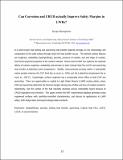Can corrosion and CRUD actually improve safety margins in LWRs?
Author(s)
Buongiorno, Jacopo
DownloadBuongiorno_Can corrosion.pdf (1.528Mb)
PUBLISHER_CC
Publisher with Creative Commons License
Creative Commons Attribution
Terms of use
Metadata
Show full item recordAbstract
It is well known that boiling and quenching heat transfer depends strongly on the morphology and composition of the solid surface through which the heat transfer occurs. The relevant surface features are roughness, wettability (hydrophilicity), porosity, presence of cavities, size and shape of cavities, and thermo-physical properties of the surface material. Recent work at MIT has explored the separate effects of surface roughness, wettability and porosity on both Critical Heat Flux (CHF) and quenching heat transfer (Leidenfrost point temperature). Briefly, interconnected porosity within a hydrophilic matrix greatly enhances the CHF (by as much as ∼60%) and the Leidenfrost temperature (by as much as ∼150 °C). Surprisingly, surface roughness has a comparably minor effect on both CHF and quenching. There are opportunities to exploit in Light Water Reactor (LWR) nuclear plants, where CHF and quenching determine the thermal margins in during loss-of-flow and loss-of-coolant accidents, respectively, and the surface of the fuel naturally develops porous hydrophilic layers because of CRUD deposition and corrosion. This paper reviews the MIT experimental database generated using engineered surfaces with carefully-controlled characteristics, and discuss its applications to LWR safety, both design-basis and beyond-design-basis accidents.
Date issued
2013-08Department
Massachusetts Institute of Technology. Department of Nuclear Science and EngineeringJournal
Annals of Nuclear Energy
Publisher
Elsevier
Citation
Buongiorno, Jacopo. "Can corrosion and CRUD actually improve safety margins in LWRs?." Annals of Nuclear Energy 63 (January 2014), pp.9-21.
Version: Author's final manuscript
ISSN
03064549